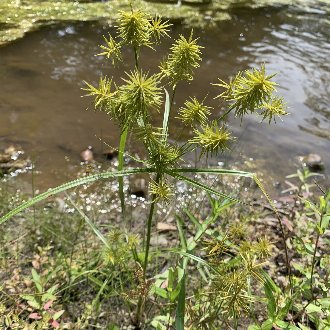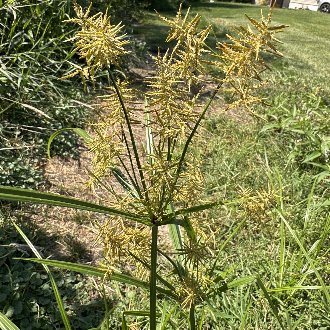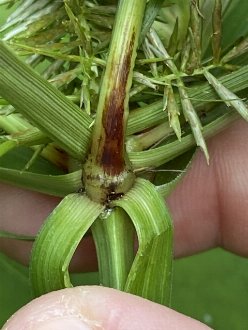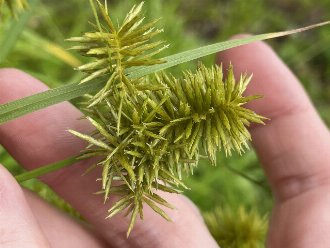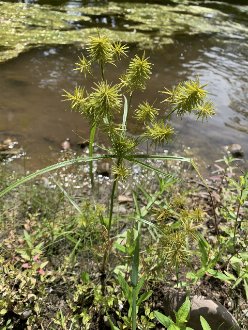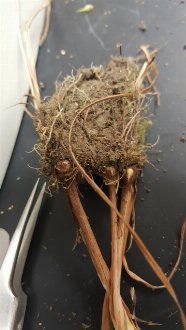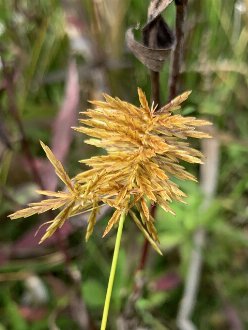Straw-Colored Flatsedge (Cyperus strigosus L.)
Also known as false nutsedge, strawcolored flatsedge.
↑Summary
A native perennial flatsedge of moist to wet areas, especially sunny wetlands.
↑Range - Expand
| Legend | Color |
| Native | |
| Native or Not Present |
This tentative map is based on our own research. It may have limited data on Canada and/or Mexico, and there is some subjectivity in our assignment of plants as introduced vs. expanded. Read more in this blog post.
Although this plant occurs somewhere in each of these regions, it may only occur in a small part of some or all of them.
↑Similar Plants
↑Habitat
Straw-colored flatsedge is found in a variety of sunny wetlands, particularly on soils that are seasonally wet but become dry in the summer. It is common in central to eastern North America and uncommon and scattered from the West Coast to the Interior West. Natural habitats include shores of ponds, rivers, flat depressions in floodplains or wet prairies, and sedge meadows. Anthropogenic habitats include ditches along roadsides and railroads, and low, wet spots in fallow fields, yards, and gardens.
This species tolerates a variety of soil textures, including mud, sand, and gravel; it prefers mineral-rich soils and is less likely on peaty, mucky, or organic soils. It needs substantial direct sunlight and is absent from forested swamps, but tolerates some competition from ground-level vegetation, responding to such competition by growing taller stems to reach light.
Although it can occur in gardens, this sedge is less likely than yellow nutsedge (Cyperus esculentus) to move into lawns.
It has some tolerance to fire and can sometimes be found in habitats, such as in Florida, the Great Plains, and the Central California Valley, that burn during the dry season or prolonged periods of drought. In Florida, the fire season coincides with the beginning of this species' growing season.
↑Life Cycle
This species is a rhizomatous perennial that reproduces both vegetatively and by seed. Unlike yellow nutsedge (Cyperus esculentus), it does not form tubers, instead storing its energy in a corm-like swelling at the base of each stem. Shallow, fibrous roots grow from each such swelling, and the plant then grows longer, spreading rhizomes.
Relative to yellow nutsedge, this species invests more energy into seed production and less into vegetative spread, although there is also a degree to which the vegetative spread of this species is more efficient in part because it has a longer evolutionary history in colder regions. The perennial parts of this plant are more cold-hardy and thus do not need to be buried as deeply in order for the plant to survive the winter.
Although it usually grows in wet habitats, it tolerates substantial periods of temporary drought due to its reliance on C4 metabolism which uses water for photosynthesis efficiently.
↑Faunal Associations
Relatively little is known about the faunal relationships of this species in particular. Its main value to larger animals is through its seed, as the seed is nutritious and seed production tends to be substantial. The seed spikes are eaten by numerous wetland birds, including dabbling ducks, Canada Goose, red-winged blackbird, and bobolink. Birds likely help distribute the seeds as some pass through their digestive tracts intact; seeds have been recorded germinating after passing through the digestive tract of killdeer. This mechanism likely is how this species established isolated inland populations in arid portions of the West where suitable habitats are few and far between.
Canada goose also eat the foliage. Cattle will sometimes browse on this plant, but do not prefer it.
We found little information on lepidoptera that feed on this species specifically. The stems and leaf sheaths are eaten by the five-barred glyphipterid moth or flatsedge borer moth (Diploschizia impigritella). Other lepidoptera that feed on Cyperus species likely also eat this plant. It is also eaten by the gall midge Planetella caudata, and the sap is eaten by the yellow sugarcan aphid (Sipha flava), which primarily eats grasses, the viburnum-sedge aphid (Ceruraphis eriophori), and the blissid bug (Ischnodemus rufipes).
↑Uses
This species is not widely grown or used for anything. It is occasionally viewed as a weed but usually not as agriculturally important as the nutsedges, due to its tendency to stay restricted to poorly-drained, consistently-moist sites.
Like other sedges, this species has a large ability to filter water, absorbing both pollutants and excess nutrients. It can be planted along natural waterways in restoration projects, or in artificial wetlands or ditches before water drains into natural waterways, for the purpose of cleaning the water. It often colonizes these sites on its own, without the need to be planted.
↑Related Plants
The exact relationship of this species to other Cyperus species is not known. Phylogenetic analysis by Reid (2016) placed it as closest-related to a group of sedges including pine barren flatsedge (Cyperus retrorsus), fourangle flatsedge (Cyperus tetragonus), ovateleaf flatsedge (Cyperus ovatus), bristly flatsedge (Cyperus hystricinus), Baldwin's flatsedge (Cyperus croceus), all of which are native te the southeastern US and have much more restricted ranges than this species, but overlapping in range. This grouping was more broadly placed into a clade that included sections previously labeled as Umbellati, Laxiglumi, Strigosi, and Tetragoni, but did not include all members of such groups, suggesting previous classification schemes may have been flawed and some or all of these sections were paraphyletic, not including all descendant groups.
↑Links & External Resources
• Cyperus strigosus (Straw-colored Flatsedge) | Illinois Wildflowers (About This Site)
• Cyperus strigosus (strawcolored flatsedge) | USDA PLANTS Database (About This Site)
• Cyperus strigosus | Go Botany (About This Site)
• Straw-Colored Flatsedge | iNaturalist (About This Site)
• Cyperus strigosus | Biota of North America Project (BONAP) (About This Site)
• Cyperus strigosus | NatureServe Explorer (About This Site)
• Cyperus strigosus | Flora of North America (About This Site)
• Straw-colored Flatsedge | Maryland Biodiversity Project (About This Site)
• Cyperus strigosus L. (Straw-colored Flatsedge) | Digital Atlas of the Virginia Flora (About This Site)



